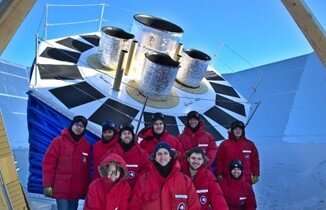BECEP array installed at South Pole

Professor Clem Pryke and his group are on their way back to Minnesota from the South Pole in Antarctica after completing installation of the new BICEP Array Telescope. Over the next few years this specialized radio telescope will study the Cosmic Microwave Background—an afterglow from the Big Bang—looking for the imprint of gravitational waves from the beginning of time. The project, which has been several years in the making, is a collaboration between the University of Minnesota, Caltech, Harvard and Stanford.
The telescope mount is a large, custom built machine which moves and points the radio receivers on the sky. The pieces of the apparatus were delivered to a large assembly hall at the University of Minnesota in the summer of 2018. There then followed an intensive year-long process of turning the raw platform into a fully-fledged telescope complete with drive system, receivers, cryogenic refrigerators, electronics and environmental protection equal to the extreme polar temperatures (-30F in summer and -110F in winter). Then, late last summer, the entire system was broken back down into component parts, packed into crates, and shipped out to the South Pole (via California, New Zealand and McMurdo Station on the coast of Antarctica).
At the South Pole there is one day-night cycle per year and the Station is accessible only during the southern hemisphere summer (from November to February). During this period the on-site team reassembled the new telescope and and brought all of the complex supporting systems online.
Now with the departure of the main team, a single UMN scientist will remain through the six month Antarctic winter night to keep the telescope operating as it records its scientific data. The new telescope is the most sensitive of its type in the world and will continue the quest to understand the physics which governed the very beginning of our universe.
More information: For more information, see biceparray.wordpress.com/
Provided by School of Physics & Astronomy UMN





















